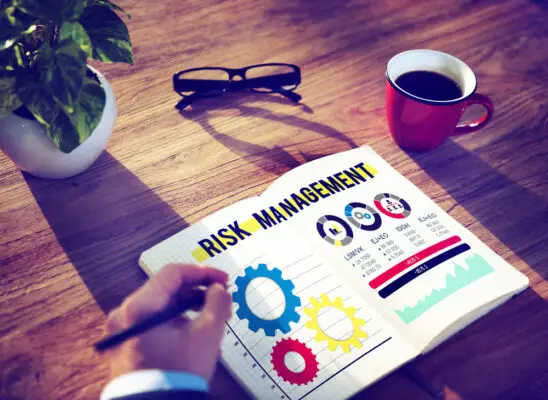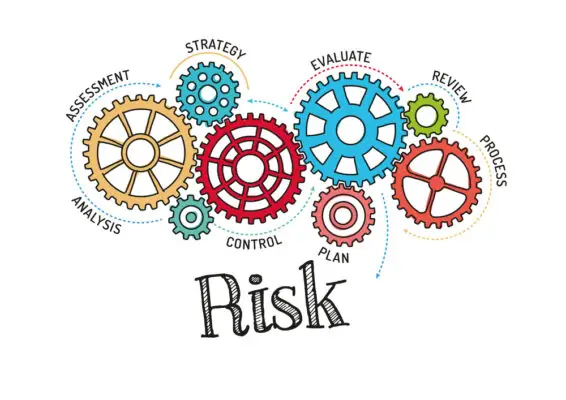Risk management in cyber security involves identifying, assessing, and mitigating potential threats to a company’s digital assets. This can range from preventing a data breach to ensuring network resilience in the event of an attack. To effectively manage risk, it is important for organizations to assess their cybersecurity measures and update them regularly as necessary.
This includes implementing strong password policies, keeping the software and operating systems up to date, and training employees on standard security protocols. Adopting a proactive approach to risk management can help protect a company from significant financial and reputational damage from a cyber attack. Ultimately, incorporating risk management into an overall corporate strategy can help businesses stay ahead of evolving cybersecurity threats.
The term “risk management” gets thrown around a lot in the business world, but what does it actually mean? In cyber security, risk management is identifying, assessing, and mitigating risks to an organization’s information assets. In other words, it’s a proactive approach to protecting your data from threats.
There are three main components to risk management in cyber security: risk identification, risk assessment, and risk mitigation. Let’s take a closer look at each one.
Risk Identification
The first step in risk management is identifying which assets are most at risk of being compromised. This involves taking inventory of all the sensitive data your organization collects and stores and all the systems and devices that have access to that data. Once you know what you’re working with, you can start identifying which assets are most vulnerable to attack.
Once you’ve identified which assets are most at risk, it’s time to assess the potential impact of a breach. This step includes estimating the likelihood of a successful attack and quantifying the potential damage such an attack could cause.
For example, if a hacker were to gain access to your customer database, how much damage could they do? Could they leak sensitive customer information? Could they delete or modify important data? Answering these questions will help you prioritize which risks must be addressed first.
The final step in the risk management process is mitigating your identified risks. This usually involves implementing security controls like encryption or user access control measures.
It might also involve increasing awareness among employees about cyber security threats and best practices for avoiding them. The goal is to make it as difficult as possible for hackers to gain access to your systems and data.
All of these threats are triggered by new, previously unknown vulnerabilities. Even at zero-day security vulnerabilities such as EternalBlue, the approach is the same: a robust risk management system that uses a systematic approach to risk assessments and responses.
Cyber security risk management is an application that combines risk management with cyber security. Iso defines risks in the sense of uncertainty in achieving objectives. Risk management involves continuous identification, evaluation, and response to risk.
Today’s businesses need to embrace digitization to stay competitive. Managing cyber risks is critical because it gives companies the confidence that the new solution will work with them while supporting third-party providers without any concerns about their security posture.
Risk management is a critical part of any cybersecurity strategy. By identifying and assessing risks, you can implement the necessary measures to protect your organization from potential attacks. But what is risk management, exactly? And how can you implement it in your organization? In this blog post, we’ll answer these questions and more. Stay safe online!

What is Cyber Security Risk Management?
Cyber security risk management identifies potential threats to an organization’s information and technology systems, assesses the risk level, and implements measures to prevent or mitigate these risks.
In today’s digital world, it is crucial for organizations to have measures in place to protect sensitive data and company assets from hackers, cyber-attacks, and other security breaches. By identifying potential vulnerabilities and taking proactive steps to address them, companies can minimize the likelihood of a costly security incident.
Cyber security risk management also involves developing a response plan in case a breach occurs and regularly reviewing and updating security measures to stay ahead of constantly evolving cyber threats.
Investing in a strong cyber risk management strategy is important for protecting an organization’s financial health, preserving customer trust, and maintaining compliance with regulations.
Ultimately, neglecting cyber security can have disastrous consequences for any business or organization- investing time and resources into effective risk management practices is essential for success in the modern age.
Cybersecurity risk management isn’t just for security teams. It is the responsibility of everyone in the organization. Frequently squired employees see risk management as part of their functions.
What is a cyber security risk assessment?
A cybersecurity risk assessment is a method of helping companies determine key business objectives and, thereby, appropriate IT assets to achieve their objectives. It identifies the cyber-attacks that could adversely affect IT asset utilization. It must determine the likelihood that these attacks would take place to determine how they will be affected. Cybersecurity risk assessments identify all threat environments and their impacts on the organization’s business goals.

Cyber Risk Management Frameworks
Cyber security management frameworks contain various standards organizations can apply for assessing and managing risks. Senior management and security managers utilize this framework to evaluate the security posture of organizations and manage cybersecurity risks. It borrows from the enterprise risk management cyber security guidelines. The guidelines give out risk management examples to be used by organizations.
A cyber risk management system will assist organizations in managing risks effectively and identifying security processes and procedures. It is also called a cyber risk management framework.
Prioritize Cyber Risks
Determine risk levels using cost, preventive and value information to support a risk management strategy. Risks at higher levels should be resolvable immediately, while lower risks should be addressed later or accepted as a tolerated risk. The cost of protecting assets above their value makes them unlikely to be worth it if the risks are likely to affect their reputations.
Identify value-creating workflows
Find and define the workflows that generate the most profit and reduce risk. The impacts could be substantial for critical workflows as they may also create risks.
The payment process is a business risk as it can cause fraud. Make sure the cybersecurity team knows what processes you think are valuable and defines the components of each process. You may now use these commands if necessary.
Build Cybersecurity into the Enterprise Risk Management Framework
Integrate the security strategy into the enterprise risk management plan that functions in an analysis of enterprise risks. The structure cannot be used as an outline but as an organizational principle. The concept is based on the idea that cyber threats are business hazards, and this approach helps businesses to manage cyber risks more effectively.
Implement ongoing risk assessments
Continually assess and identify the risks to stay updated with changing threats, technology, and strategies. Regular evaluation of risk management practices to identify and correct a problem. Cyber security managers use data to analyze risks for digital assets and infrastructure security and safety.
Standards
ISO 27001
ISO is the world’s first ISO-IEC 270001 standardized standard developed in collaboration with the IEC. ISO/IEC 270001 provides standardized standards based upon standardized standards for managing information system security risks. Similarly, organizations are encouraged to use ISO 31000 standards to guide enterprise risk management activities and create a cyber risk management approach.
NIST CSF
NIST’s cybersecurity framework has many applications. NIST CSF offers comprehensive best practices to standardize risk management. It describes the activities related to cyber risk management—protected detection, identified, responded to, and recovered activities. The framework offers a technology cybersecurity framework to issues cybersecurity risk management.
FAIR Framework
It has been developed to help companies measure, analyze, and comprehend information risks. The objective is to assist organizations in determining best practices regarding cybersecurity and create a cyber risk management initiative.

Cybersecurity Risk Management Process
In assessing risks, organizations usually take four steps to identify potential risks. Risk is then evaluated according to the probability that threats exploit vulnerabilities and potential impacts. Risk management has priority, and organizations can choose from several mitigation strategies.
Finally, monitoring is organized to control and manage current risks despite changing conditions. It can be very helpful if a firm wants to measure its risk level. You can also look at how to carry out information security risk management article.
Identify Cybersecurity Risks
Gartner defines IT Risks as the potential for unplanned and negative outcomes involving IT failure”. How can we detect and mitigate vulnerabilities? Risk assessment is the first step in managing risk. Modern security teams face challenges in IT systems — growth, regulation, explosions — and COVID — resulting in varying risks worldwide. When assessing the risks you need, you first must understand the risks and weaknesses associated with their convergence. The security risk management guide enumerates examples of cybersecurity risks.
Assess cyber security risks
Risk assessments can help you identify your organization’s security needs and ensure that all personnel is secure and productive. Developing a risk management strategy is key to developing and deploying scalable strategies that improve risk management.
What are organizations’ risks? Evaluation is an important decision when answers are clearly given. Start with the name of each asset and assign priority. Secondly, find any potential threats or weaknesses within your environment. Identify known vulnerabilities and implement appropriate controls. You can use information security risk criteria established earlier to assess risk.
Identify Cybersecurity Risk Mitigation Measures
It is only the beginning of assessing the risks. What are the most effective actions for reducing risks? How can I mitigate a problem by taking steps to minimize the risks? Risk management plan for a cyber security will provide details of various mitigations.
History shows us that risk management is a process of planning to help a team to implement an effective risk-reaction strategy. The crucial third step of a successful response begins with understanding every potential mitigation strategy. Technically, security measures can include eavesdropping, firewalls, security hunting, and automation to increase efficiency.
Use Continuous monitoring
Changes can always occur, and you must monitor environment controls to ensure internal controls align with security risks.
Managing regulatory change ensures that internal controls are aligned with external expectations. Vendor risk management– Take the time to evaluate if a new vendor joins and evaluate the information security risks of vendors.
Critical Capabilities for Managing IT Risk
Assessing risks was never easy, but now COVID-19 and the recession make IT Risk Assessments much harder. How can we navigate this new world? Your organization can use the tools it needs to conduct an IT assessment.
Risk management frameworks
Make sure that the risk assessment process of an organization is guided by external risk assessment frameworks such as NIST 800-30. They provide third parties with an easier way of performing an accurate gap analysis between the requirements of a compliance audit and current operations. Organizations can also develop a framework to initiate Internal Of Things( IoT) project risk assessment.
Collaboration and communication tools
As team members participate in an organization’s assessment or mitigation phase, the tools needed are needed for efficient communication. It is essential to have clear records of conversations with people in different countries and different time zones if the organization is an international organization.
Issue Management Tools
This tool arranges the assignment of specific mitigation measures and automatically identifies tasks that must be completed quickly. It also informs managers of the status of a task being completed.
Analytics
Easily used for root causes, predictive analysis, and emerging risk assessment. This is for risk management professionals to record risk assessments, tests, documentation, and information. The best enterprise risk management technology can be used for analysis.
Conclusion
Although cyber security is always evolving, risk management is a core component that will help protect your company’s data. Risk management is a critical component of any cybersecurity strategy. You can proactively protect your organization from attacks by taking steps to identify, assess, and mitigate risks.
Implementing strong security controls is essential for mitigating risks, but employee education is also key; humans are often the weakest link in any security system. Following a sound risk management process is essential to reduce the risks to your organization’s information assets.

Chris Ekai is a Risk Management expert with over 10 years of experience in the field. He has a Master’s(MSc) degree in Risk Management from University of Portsmouth and is a CPA and Finance professional. He currently works as a Content Manager at Risk Publishing, writing about Enterprise Risk Management, Business Continuity Management and Project Management.

